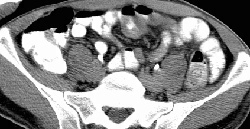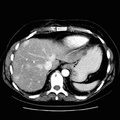
RADIOLOGY: GASTROINTESTINAL: GI: Case# 125: B-CELL LYMPHOMA-PLEOMORPHIC, LARGE JEJEUNAL & DUODENAL MASSES. 45 Year old male with AIDS, recently treated with XRT for oral lymphoma, presented with GI hemorrhage. Upper endoscopy revealed a 2 cm duodenal ulcer which appeared malignant. CT reveals focal bowel wall thickening in the mid jejunal region with an irregular lumen consistent with an ulcerative mass. The cause of lymphoma is not known although viruses, radiation, and certain genetic conditions have been implicated. In addition, immunosuppressed patients, e.g. those undergoing renal transplant or those with AIDS, show increased frequency of lymphomas. Lymphomas are classified as low-grade (small lymphocytic cell, follicular-mixed cleaved cell, and follicular-mixed small cleaved and large cell), intermediate-grade (follicular-large cell, diffuse-small cleaved cell, diffuse-mixed small cleaved cell, and diffuse large cell), and high-grade (large cell immunoblastic, lymphoblastic cell, and small non-cleaved cell). Most AIDS-associated lymphomas are high-grade, usually of small non-cleaved or immunoblastic histologic subtype. Extranodal involvement is especially common in AIDS patients with GI or intracranial involvement occurring frequently. Many patients present with lymphoma late in the course of HIV disease, and although chemotherapy or radiation may provide brief clinical responses, patients rarely survive more than 6 months following diagnosis. Abdominal CT usually shows diffuse or focal thickening of the bowel wall, which may be nodular or circumferential, and discrete masses of lymph nodes within the mesenteric loops supplying the involved segment.
- Author
- Peter Anderson
- Posted on
- Thursday 1 August 2013
- Tags
- gastrointestinal, radiation, radiology
- Albums
- Visits
- 3061


0 comments